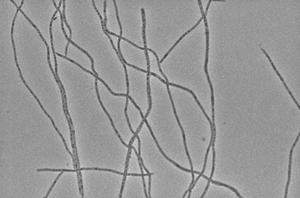The phylum Chloroflexi is a deep-branching lineage of the Bacteria, and most of its best-described members are thermophiles capable of chlorophototrophy (light-energy conversion based upon chlorophyll). However, recent survey studies of microbial diversity suggest that Chloroflexi are probably much more widely distributed in nature than previously appreciated. The filamentous anoxygenic phototrophs (FAPs) of this phylum are metabolically versatile organisms that inhabit a wide range of aquatic and mat habitats. The thermophilic FAPs that inhabit the microbial mats of alkaline and neutral hot springs have been described in most detail, and they typically live in association with cyanobacteria at low sulfide concentrations (Castenholz and Pierson 1995). In particular, the alkaline siliceous hot springs in Yellowstone National Park (WY, USA) are inhabited by organisms that are closely related to both Chloroflexus and Roseiflexus species (Nübel et al., 2002). Similar to Chloroflexus aurantiacus, Roseiflexus spp. grow optimally as photoheterotrophs in culture, yet they also have the ability to grow as aerobic heterotrophs (Hanada et al., 2002). Similar to purple anoxygenic phototrophs and Chloroflexus aurantiacus, Roseiflexus spp. possess the pheophytin-quinone-containing Type II reaction centers, and they have membrane-bound, and bacteriochlorophyll a containing, light-harvesting complexes (Yamada et al., 2005). However, in contrast to Chloroflexus aurantiacus, Roseiflexus spp. do not synthesize bacteriochlorophyll c and therefore lack chlorosomes (Hanada et al., 2002). This difference, and their abundant carotenoids, has caused Roseiflexus spp. to sometimes be referred to as “red Chloroflexus.” It is not currently resolved whether Roseiflexus spp. are able to grow photoautotrophically using the 3-hydroxypropionate pathway. Although photoautotrophic growth has not been achieved in laboratory cultures, both Roseiflexus castenholzii and Roseiflexus sp. RS-1 contain the suite of genes required for this metabolism (Klatt et al., 2007). Other aspects of their physiology, metabolism, and genetics are largely unknown. Roseiflexus sp. RS-1 was isolated from the phototrophic microbial mats of Octopus Spring in Yellowstone National Park at 60°C (Madigan et al., 2005). Roseiflexus sp. RS-1 is a gliding, filamentous bacterium that can utilize small concentrations of sulfide (120-240 µM) as an electron donor. Growth on acetate, pyruvate, and other organic acids is possible when supplemented with 0.2% yeast extract. Molecular analyses of the FAPs associated with the mats of Octopus Spring have shown that Roseiflexus spp. are the dominant FAP at this temperature (Nübel et al., 2002). As demonstrated by light-stimulated uptake of radiolabeled 13C-labeled bicarbonate and acetate and propionate, Roseiflexus spp. appear to perform photoautotrophy and photoheterotrophy in situ (van der Meer et al., 2005). References
|
||
|
||
Roseiflexus sp. RS-1

